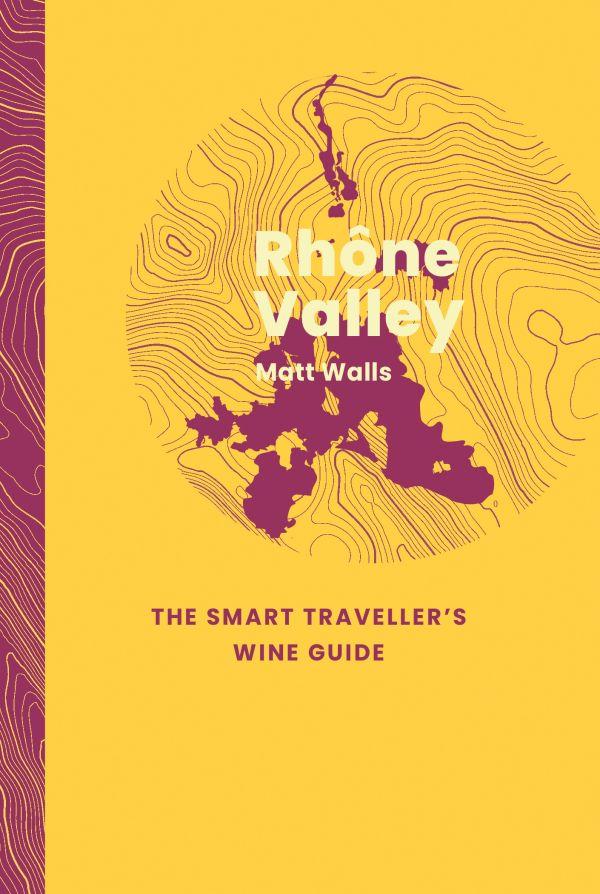
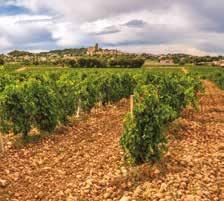
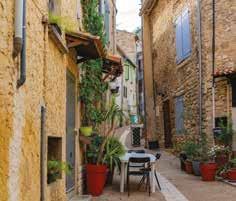
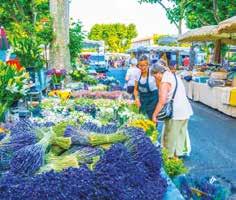


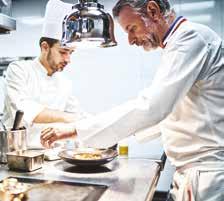










Wine has been made in the Rhône Valley for more than 2,000 years, at least since Greek settlers arrived from Anatolia in 600BCE, when they founded the city of Massalia – today’s Marseille– and imported their viticultural skills. In the first century CE, the Roman author Pliny the Elder noted the popularity of the wines of Vienne, which were exported as far afield as Britain and Rome.
Later, when the Popes moved to Avignon, they planted extensive vineyards around the city – now the capital of Côtes du Rhône wines.
Over the centuries the region’s renown grew; today, the wines of the Rhône Valley are universally prized, by collectors, wine aficionados and ordinary drinkers alike.
From the elegant reds of the Côte-Rôtie and Hermitage to the generous, sun-drenched blends of the southern Côtes du Rhône Villages, Luberon or Ventoux, there are few wine regions that can offer such diversity.
It is also important to remember that the Northern and Southern Rhône are very different. The south – olive groves, lavender plantations, fields of sunflowers and (of course) vineyards – is Mediterranean in character. The north is more rugged and dramatic, with terraces that follow the corrugated, vertiginously steep contours of the hillsides. These contrasting landscapes produce wines of a different style: northern reds tend to be fresh and juicy compared to the plumper, voluptuous reds and whites of the south.
But the Rhône Valley offers so much more than wine. With its tree-lined roads dappled with sunlight, its ancient villages, bustling squares, Roman theatres, medieval castles and quiet chapels, for many it’s an archetypal vision of France.
Whether you’re wine-curious, a collector with a cellar of the best Rhône wines, or simply a lover of southern France, this book will help you explore a region where every sip and every step brings you closer to the heart of French wine culture.
Philippe Pellaton President of Inter Rhône
The history of winemaking in southern France dates back to around 600 BCE. The domestication of the vine goes back considerably further elsewhere – in Iran and Georgia, for example, to around 5000 BCE. Nonetheless, it’s fair to say the French have had more practice at making wine than most.


Most of us drink wine primarily for the immediate pleasure it offers. But like most arts and crafts, to make sense of what’s being made today – and why – it pays to know what has gone before. A sense of context and perspective deepens your drinking experience.
Rather than simply reading a book or admiring a painting, there’s something about the act of consuming a bottle of wine that somehow plugs us into this long history; there’s a sense of connection to an earlier time. The fundamentals of winegrowing haven’t radically changed, so what we taste today isn’t that far removed from what our ancestors would have tasted centuries ago.
So pour yourself a glass, and let’s go back to the start. For the Rhône Valley, that means the ancient Greeks.
Around 600 BCE, Greek settlers arrived in Southern France from Phocaea in Anatolia and founded the city of Massalia, known today as Marseille, close to where the Rhône river flows into the Mediterranean. One of the Greeks’ many valuable imports was viticulture – they knew that vines grew happily alongside figs and olives, so they planted vineyards.
In the 2nd century BCE, Massalia came under Roman control, as it was an important stop on their trading route with Saguntum (present-day Sagunto, near Valencia in Spain). With the Romans, the vine spread further north. The Rhône has always been a vital communication route; fragments of clay amphorae used for wine storage have been found along the length of the river.

The Southern Rhône is a huge region with multiple microclimates. So the reds here range from medium-bodied and ruby-coloured with crisp berry fruits in the cooler mountain fringes – all the way to thunderous, booming, powerful wines in the hottest, driest areas.

Chapelle Saint-Christophe, Hermitage

The fresher Northern Rhône produces red wines with a tighter stylistic range. They’re typically medium-bodied, with more refreshing acidity and a slightly drier texture –they’re not as fluid and plump as the wines of the south, and are more floral and spicy.
This isn’t down to climate alone – it’s also down to the grapes they grow. Northern Rhône reds get their aromatic side from Syrah – it’s the only red grape cultivated here, and that’s the style of wine it gives. In the Southern Rhône, almost all reds are blends of different grape varieties, but majoring on Grenache, which produces a richer, more strawberry-flavoured wine.
The whites follow the same pattern – from fresh and juicy to voluptuous in the Southern Rhône, and more medium-bodied in the North. Both can be delicious but the Northern Rhône is more consistent in style and quality.
Rosé is only made in the Southern Rhône – there’s no tradition of pink wines in the north. There are two contrasting styles. Firstly, the ubiquitous pale, dry style that’s become world famous thanks to Provence (which is, after all, right next door to the Rhône). They don’t demand much thought and are crisp and refreshing on a hot day. The other style is the ‘traditional’, darker-coloured rosé. The Southern Rhône was once famous for this style (in the Cru of Tavel, specifically), and – though unfashionably dark in colour – they can have real depth, complexity and foodfriendliness. Some can even age for decades – rare for a rosé.
All of the above comments relate to dry wines. Wines are either fully dry or very sweet in the Rhône; there’s nothing in between. There aren’t many sweet wines, but they can be a delicious treat. In the Southern Rhône, Muscat de Beaumes de Venise has been made for over 2,000 years, and sweet Rasteau (called Rasteau Vin Doux Naturel, meaning Natural Sweet Wine), is reminiscent of young Port. In the Northern Rhône, sweet wines are rarer still.
Sparkling wine is more common in cooler climates, so you won’t find much here – except in the little Northern Rhône Cru of Saint-Péray.
In the history of wine, there is no equivalent to Châteauneuf-du-Pape. This great appellation attracts visitors from around the world to its vineyards, and its wines are objects of fascination, even adoration. But Châteauneufdu-Pape has never become insular or ‘Disneyfied’ – we’re proud of our open sense of hospitality that keeps people at its core.
At the heart of the Châteauneuf-du-Pape wine tourism experience is La Vinothèque, a dynamic cultural and tasting space created by the winemakers’ association. Housed in a beautifully restored former cellar, this venue represents the beating heart of the appellation’s collective spirit. In the old papal town’s ramparts, La Vinothèque offers visitors more than just wine – it’s a gateway to understanding what makes Châteauneuf-du-Pape truly unique.
Your journey of discovery starts with a 45-minute discovery tasting (€25) led by a professional sommelier. In an ideal introduction to the region’s style and diversity,

you’ll taste five emblematic wines (four reds and one white). For those who wish to go deeper, La Vinothèque also hosts prestige tastings that explore the nuances of vineyard plots, winemaking techniques and ageing choices (60 minutes, €40).
Other specialized sessions include sensory tastings (€35), vertical or horizontal tastings and specially tailored masterclasses (available on request). Each expertly guided – and convivial –tasting will deepen your understanding of wine.

This unique approach reflects the broader philosophy of Châteauneuf-du-Pape – a region that resists standardization and embraces character, individuality and the slow pleasures of discovery. La Vinothèque is more than just a tasting room: it’s a cultural hub where education, heritage and enjoyment converge.
The village also hosts numerous seasonal events such as Les Printemps de Châteauneuf-du-Pape, a springtime wine fair, or La Fête de la Veraison, a medieval-style celebration held each August. Châteauneuf-du-Pape offers unforgettable moments to wine lovers and the wine-curious alike.
In a world where everyone’s in a hurry, Châteauneuf-duPape is a haven where every glass tells a story and every visit creates a lasting connection.
For more information and booking visit chateauneuf.com
Caption
There are marked differences between the Northern Rhône and the Southern Rhône. The sizzling south has long been a holiday destination for both national and international holidaymakers, so it has a well-developed travel and tourism network. There are countless activities to suit all tastes and all ages, on top of a food and wine scene that can amply entertain even the most gluttonous.


The Northern Rhône offers a different type of holiday. It has its fair share of visitors, but it’s not as geared up for tourism; whether that’s a good or bad thing depends on the experience you seek. It’s not as picturesque as the south, and it has fewer attractions and activities for children. But its landscapes are stunning, it’s not as scorchingly hot in summer and there are fewer crowds.
If you’re a dedicated wine lover, the choice will likely be driven by your preferred style of wine – if you collect Châteauneuf or go weak at the knees for Northern Rhône Syrah, the choice will be clear.
If you’re just exploring the north, Lyon is the obvious starting point. Grenoble Isère Airport is 90 minutes’ drive away; Lyon Saint-Exupéry Airport to the centre of town takes less than an hour by car, or half an hour on the Rhônexpress tram. Lyon is easily accessible via the Eurostar from London by changing trains in Paris or Lille and taking a TGV to arrive in central Lyon at the Gare Part-Dieu.
If you’re concentrating on the south, Marseille Provence is a good airport option, or Montpellier Méditerranée.
Hiring a car is strongly recommended to explore the Southern Rhône. If you use Avignon as a base, there are local buses (reliable) and local trains (fairly reliable), but it’s advisable to do some timetable research before you set off. If you want to visit wineries, a car will vastly open up your options. Taxis are inexplicably, eye-wateringly expensive. Exploring the Northern Rhône without a car would be even more challenging, but hiring bicycles from Tain l’Hermitage or Tournon could be an option. If you do hire a car, be aware that motorways charge tolls if you use them, and GPS systems and online maps are liable to send you on unsuitable
Ste-Foyl’Argentière
Main
• Activity: Take a tram or bus to Les Halles Paul Bocuse and immerse yourself in this temple of French gastronomic delight. If the weather is good, take your haul to the Parc du Tete d’Or for a picnic, just 20 minutes away by foot.
Evening
• Dinner: You’re unlikely to want a huge meal by this point, so visit Le Dôme at the InterContinental Lyon –Hotel Dieu for cocktails and snacks.
Morning
• Activity: Visit Domaine Barge in Côte-Rôtie or Domaine Rémi Niero in Condrieu (see The Guide).
Afternoon

• Lunch: Informal lunch at Les Epicurieux. The walls are lined with bottles; it’s a great selection that you can buy to drink in or take out. See if you can spot any winemakers!
• Activity: Follow the hairpin bends up the slopes to Tupin-et-Semons for the little Belvedere walk with views over the vineyards – selfies galore. Pop into La Bouteillerie in Condrieu to pick up some hard-to-find bottles.
Evening
• Dinner: If you want to drive back to Lyon before dining out, go to Café Terroir and dig into its excellent wine list. If you’d prefer a view of the vineyards, visit the refined Les Gagères in Tupin-et-Semons.


listings prepared by
Matt Walls



Caption
When it comes to hotels in Lyon, you’re spoilt for choice. Among the vineyards of the Northern Rhône, however, there aren’t so many – it’s only recently started attracting international travellers in significant numbers. There are some luxurious options topping and tailing the region in Vienne and Valence, and several dependable places around Ampuis and Tain l’Hermitage.


There is an abundance of choice throughout the south, with countless hotels dotted all over the region – whether you’re looking for clean lines and modern facilities, or you prefer to bathe in the faded grandeur that Provence does so well. Most of the larger hotels are in and around Avignon, but there’s no need to base yourself in a city; if you’d prefer to stay in a village – or even in the middle of nowhere – you’ll find somewhere that caters for you.
Villa Maïa, Lyon
€€€€€
Considering that Villa Maïa only opened its doors in 2017, it feels remarkably well-established. It’s partly thanks to its Art Deco-inspired décor, created by celebrated interior designer Jacques Grange, which gives this elegant address a contemporary but timeless feel. It’s located in a quiet neighbourhood on the Fourvière hill, with views across the city, which offers the best of both worlds – you are far from the crowds, but can reach Place Bellecour in less than 20 minutes on foot; to get back up, you can take the funicular railway. There are 34 rooms and suites in total, giving the place an intimate feel, with large indoor baths, a spa and a small, wild, grassy garden. The compact bar offers non-stop service all day, and is open to all – not just hotel guests. There is no on-site restaurant, but next door you’ll find Christian Têtedoie’s Michelin-starred
restaurant and bistro. It’s a hotel with an undeniable cool factor.
villa-maia.com
€€€€
The Grand Hôtel Dieu, on the right bank of the Rhône, spent most of its 900-year life as a hospital, but that chapter came to an end in 2010. Its rooms, halls and cloisters are now inhabited by a high-end retail centre and the InterContinental Lyon - Hotel Dieu. The 144room hotel opened its doors in 2019, and still feels box fresh. It’s suitable for both business travellers and couples on holiday; it’s a professional, smart, luxurious establishment that speaks the international language of fine hotels. Thanks to its long façade, half the elegant, high-ceilinged rooms have views over the Rhône. There are two dining options: their restaurant Epona and bar Le Dôme. The wine list they

